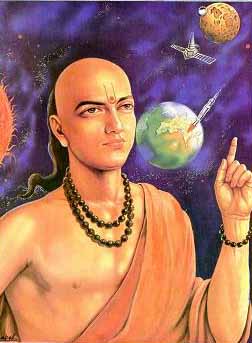Nayan Walia
The Lunisolar Calendar of India
The first Astronomical treatise was the Surya Siddhanta, the ancient and well-known treatise. It put in place many astronomical rules, such as how to determine the true motions of the luminaries. It was written in 400 A.D. when positional astronomy, finding the exact position of an object in the sky, was not every advanced. Yet the Siddhantic methods were pretty accurate; for example: the difference in the Siddhantic mean length and the modern mean length of the sidereal year is only some three and a half minutes. The Indian solar and lunisolar calendars are based on the common principles found in the Surya Siddhanta. Quite a few facts have been used from the Vedas to form this calendar also. A very famous astronomer who discovered many important things, such as the earth spins on an axis, indirectly helped shape the calendar with his many calculation both about the earth and the solar system. This astronomer was Aryabhata.

Aryabhata
This calendar system, the lunisolar calendar, fuses the solar and lunar calendar systems to form this lunisolar calendar, which tracks the sidereal year, and uses the lunar months and the solar years and adjusts to leap years by inserting additional months. Since the 12 months of 29.5 days, the year has 354 days. This sets back each religious festival 11days each year, so once every three years and extra month is added. The Indian lunisolar calendar measures days from sunrise to sunrise, this lengthens and shortens the days according to the seasons.
Accoding to this calendar, the year begins when the su n is in the astrological sign Aries. The first day of the lunar month is when a new moon accures before sunrise. Hence it is apparent that the end of the lunar month is the day of the new moon. The lunar month is the 30th partof the lunar month, about 29 and a half solar days. The 12 lunar months have 29 or 30 days.
| Month |
Number
of days
|
| Caitra |
30* |
| Vaisakha |
31 |
| Jyaistha |
31 |
| Asadha |
31 |
| Sravana |
31 |
| Bhadra |
31 |
| Asvina |
30 |
| Kartika |
30 |
| Agrahayana |
30 |
| Pausa |
30 |
| Magha |
30 |
| Phalguna |
30 |
The week is divided into 7 days, exactly like the Gregorian calendar system. Each day corresponds with one of the seven planets(those they knew of and believed in.) Each day is also related to a particular deity.
Sunday - Sun
Monday - Moon
Tuesday - Mars
Wednesday - Mercury
Thursday - Jupitar
Friday - Venus
Saturday - Saturn
According to the time of the year in relation to the planet Jupiter's orbital revolution help date the years. The sidereal period of Jupiter, or the movement around the sun with respect to the stars in a fixed position, is nearly 12 years.After that time, Jupiter will come back into conjunction with the stars from which it began its orbit. But its synodic period is little over a year. In five cycles, a 60 years period, is what became known as the "century." On the opposite end of this calculation, an hour was known to be 48 minutes, while a full day would be about 30 hours.
The classical calendar had been influenced by the Hellenism, Greek, and Mesopotamian astrology and astronomy.
Today there are sveral regional Indian calendars, including the Indian national calendar. They all came from the Hindu calendar used in ancient Vedic times, changing many times to arrive where it is today.
The months corressponding with the seasons and some festivals:


Works Cited:
-
http://www.crystalinks.com/indiastronomy.html
-
http://www.infoplease.com/ipa/A0877711.html
-
http://www.infinityfoundation.com/mandala/t_es/t_es_shah_m_astronomy_frameset.htm
-
Comments (8)
Anonymous said
at 1:00 pm on Oct 14, 2008
Your page is really nice! The information you gave was concise and provided just enough background to allow an understanding of what you were trying to say. I really liked your use of charts and graphics. They really helped add to the presentation of your information. Overall, it is a very nice web page and enjoyable to read. However, I think you should have separated your information into separate sections for it would allow people to find certain facts easily.
Anonymous said
at 12:59 pm on Oct 14, 2008
Your project was well done. It was informative and you explained all of the parts of the calendar well. It was interesting.
Anonymous said
at 12:55 pm on Oct 14, 2008
Nayan your website is really informative, it contains a lot of information that was an enjoyable read. The graphics were amusing especially the first picture with that man and the crazy background. Overall it was wonderfully done.
Anonymous said
at 12:39 pm on Oct 14, 2008
!!!
Anonymous said
at 12:39 pm on Oct 14, 2008
I'm sorry
Anonymous said
at 12:39 pm on Oct 14, 2008
Mr. Ovetsky I don't want an F!!
Anonymous said
at 12:36 pm on Oct 14, 2008
Aryabhata looks so gangshta. When an extra month is added every three years, is it in order to keep up with the 365 day cycle? like 354 x 3 + 30 = 365 x 3? I'm too lazy to do the math. There's a lot of holidays in the hindu Calendar. All in all, I liked reading it, you deserve Oveskie's praise.
Anonymous said
at 12:34 pm on Oct 14, 2008
I thought that it was informative. It contained a lot of info on the astronomical basis of the calendar, which was good! You stay on FOCUS! You might want to add some extra details about the calendar in the beginning to help people get familiar with it. Overall i like it.
You don't have permission to comment on this page.